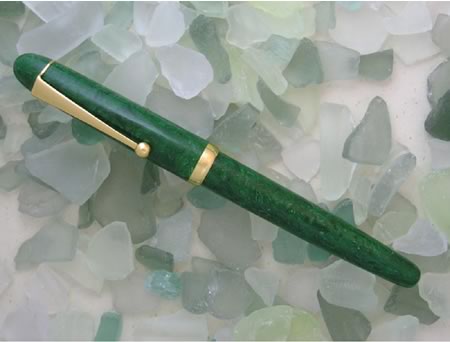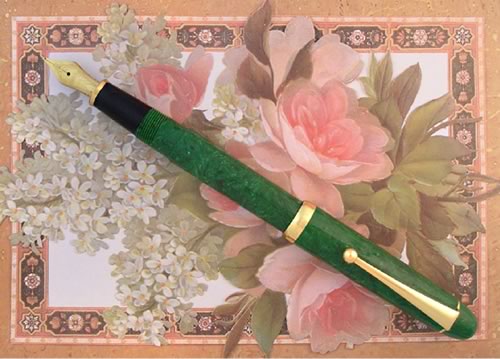|
I’m not sure why but green pens seem to cross my path quite often. I
look in my pen case at my rather meager collection and see the green Phileas of
1996, the marbled green Pelikan M200 of 1997, and the translucent green M200 of
2003. On the vintage end are the mottled green Bantam fountain pen and pencil
made in the 1930s and a plain green late-1960s Esterbrook cartridge filler. I
think, “Do I really need yet another green pen?” Worse, it strikes
me that I might not want any more green fountain pens.
So when the jade-green Columbus Academia landed on my desk for my perusal
I had no intention of falling in love with it. “It’s just another
green pen,” I told myself as I opened the shipping box. I set my mind to
the task of evaluating the pen as a gift for a friend, then I would send it on.
Well, counting chickens and never say never and all those other clichés…
I flipped the red pen case open to this rather delicate looking pen; a softly
glowing green celluloid in its cream satin bed. I was on the phone with a fellow
pen addict at that moment and my husband was nearby. “Oh yes, the Columbus
is here. Yes, it’s very nice. Darker than I expected,” I told her
in an inexpressive tone. I changed the subject then, portable phone in hand, headed
off for another part of the house. In the office, a safe distance from the hearing
of the Man of the House I said through gritted teeth, “Dang! It’s
gorgeous!” My friend, laughing of course, said she wondered why I was speaking
in such a subdued manner. Any new pen warrants some excitement. A new and beautiful
pen certainly warrants more than “Yes, it’s very nice.”
It may have something to do with the relatively small amount
of celluloid in my collection or maybe I just have to accept I have a thing for
green pens. But the warmth of this pen and it’s ever-changing malachite,
jade, and grass-green shades made me consider owning this pen just for it’s
look.

As to that “look” - the Academia was made for the Italian pen
company, Columbus, by Japanese pen maker Yamazaki, therefore the lines are very
much like the classic lines of other Japanese pens. The slim, cigar shape has
no excessive appointments: a single,wide cap band with the Columbus logo engraved
on opposite sides, a simple ball-tip clip, a single-tone, gold-plated nib, and
a gold-plated section ring.
The Academia is medium-sized, its black section is slightly narrower than
that of the Pelikan M200 but still comfortable. It probably isn’t a pen
for someone who prefers large pens. But, if you linger over the beautiful, and
often expensive, Japanese pens but are leery of their somewhat intimidating sizes,
the Academia makes an appealing and reasonably-priced compromise.
The Academia is 5 _” long capped and 6” long when posted. The
cap screws off with fine threads that cause no discomfort while in use. The cap
posts easily and cleanly with no detriment to the balance, a feature that might
improve the appeal to those who prefer medium or larger pens.
But how does it write?
I’m new to ebonite feeds for the most part and took the advice of “those
in the know”. I filled the pen (it is a cartridge/converter pen), scribble
a few lines without judging and set it aside for a while to allow the feed to
draw ink fully. When I came back I took a 9X look at the nib. The tipping is conservative
but clean – no “blobby” tipping here. I wondered momentarily
if it really would be as smooth writing as promised. Pen to paper rewards me with
immediate start-up and a very smooth write. Okay, still not in love but definitely
appreciating the Academia’s qualities.
Like many Japanese-made nibs, the Yamazaki runs finer than most Western standards.
I have a medium with wet flow in hand and it gives a fairly fine line. The nib
has very pleasant feedback. It isn’t mushy as some gold nibs feel, but a
bit springy or – dare I say it – a touch flexible. Don’t get
excited; this isn’t vintage flex. But it certainly is not a nail.
I complained that evening to my husband that I simply can’t want another
green pen! But after three days of “testing” (that is, using it for
everything I can think of including writing this review) I decided that I am due
a new green pen soon – after this particular Academia goes to a friend who
will surely enjoy the pen. The flow is delightfully consistent with no starting
or skipping problems at all over the several days the pen was in my possession.
The Problem
But of course, there is a drawback. I seem to have a knack for finding new pens
that are not-so-readily available. The Academia by Mr. Yamazaki was originally
made in 1994 and he has since passed away. The Academia was made in several celluloid
patterns: tortoiseshell, green, blue, white onyx, and a couple of “pine
needle” patterns. Some of these patterns can still be found with various
distributors. The green celluloid is the most readily available color of the Academia.
The Academia typically sells for around 100 USD.
Post-script: Since this article was conceived, a second green
Columbus Academia has arrived and now resides in my pen case. It writes as smoothly
and unfailingly as the first. Always nice to have additional data points. And
another green fountain pen. 

|